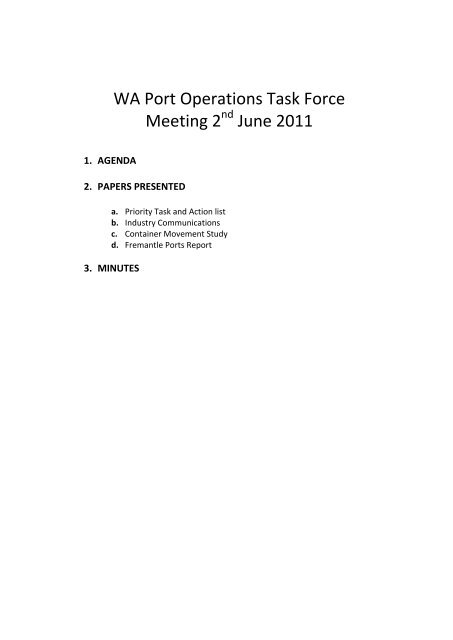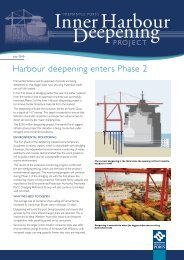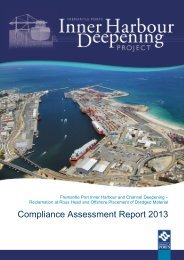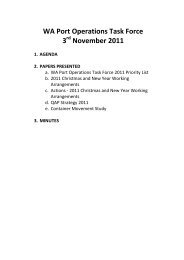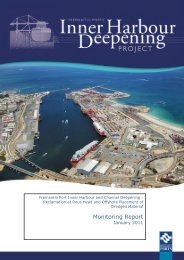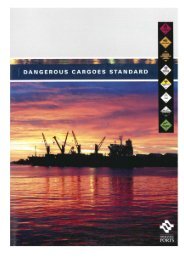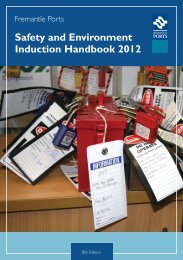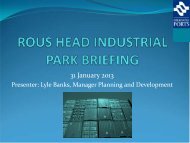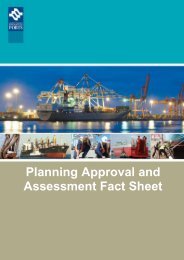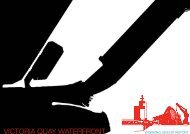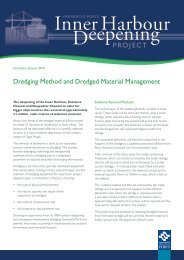WA Port Operations Task Force Meeting 2 June ... - Fremantle Ports
WA Port Operations Task Force Meeting 2 June ... - Fremantle Ports
WA Port Operations Task Force Meeting 2 June ... - Fremantle Ports
Create successful ePaper yourself
Turn your PDF publications into a flip-book with our unique Google optimized e-Paper software.
Wir machen Ideensichtbar!
<strong>Port</strong> <strong>Operations</strong> <strong>Task</strong> <strong>Force</strong> of Western AustraliaManagement of Growth in the Inner Harbour - Work Programme 2011UPDATEBroad Issue General Objective Action Current Status1. Higher TruckProductivitya) Use VBS to promote higherloading – dual bookingsystemb) Greater use of highproductivity vehicles (on andoff port)Software modifications underreview by stevedoresIndustry and FPA negotiatingwith Main Roads <strong>WA</strong>Chairman has written to stevedoressupporting the proposed change, remindingthem of how and why the dual bookingsystem was initiated and requestinginformation about their review.Under reviewc) Carrier professionalstandards2. Working Hours a) Extend weekly operatinghours to handle growth.Described in two dot pointsbelowIncluded in review of VBS.3. Removal ofImpediments to Rail4. Optimise Use of <strong>Port</strong>Land5. Greater Use of InlandFacilitiesb) Better alignment of hoursbetween stevedores andother service providers.c) Setting up transport stagingdepots within the portprecinct.a) NQRT/Stevedore Interface.b) Clear government policy onusing rail.a) Future Capacityb) Staging Depots for improvedconsolidation.a) Intermodal Terminalsb) Container ParksDP World and POTAreviewing timetable for bulkruns and ‘receipt anddelivery’ operations.FPA undertaking land useplanning and reviewing landavailability.FPA reviewing rail terminaldesign.Cabinet submissions.FPA undertaking Rous Headland use planning.Refer to 2(c) aboveDOT investigates sites inKewdale/Forrestfield area.Friendly negotiations underway; somechanges implemented and a program foradditional changes in preparation.UnderwayWorking with consultants and DOT on trainconfigurations and terminal design.Under consideration by Cabinet.UnderwayUnderwayConsultant reports on T2 in Kewdale andArea C in Forrestfield completed and under
c) Staging Depots consideration.6. <strong>Port</strong> Corridors a) Planning and protecting. Current DOT projectUnderwayb) Better information onmovements.c) Benchmarks.7. VBS improvements a) Relationship betweenstevedores and carriers.c) Independent management.Undertake Containermovement O/D studyConsultants appointed – completion byNovember 2011.8. Interim Arrangementsto control overloadingahead of Chain ofResponsibilityLegislation.d) More flexibilitya) Import boxesb) Export BoxesPrepare interim guidelinesand business rules.dittoCompleteUnderway
PORT OPERATIONS TASK FORCECONTAINER MOVEMENT STUDY UPDATE - JUNE 2011A Request For Proposal (RFP) was issued prior to Easter. The focus of the RFP wasto utilise the groundwork laid by <strong>Fremantle</strong> <strong>Port</strong>s in contacting stevedores, emptyparks, rail operators and transport providers to carry out an initial 72 hour trial, toverify the efficacy of the data received and then to carry out a two week full study ofcontainer movements. The focus would be on stevedore to importer, importer toempty park, empty park to exporter and exporter to stevedore as the main movements.Direct movements from parks to terminals are not discounted.The priority requirements were:Ultimate destination and origins of import and export containers;Location and use of staging depots;Movement of empties;Rail movements;Time required for each element of the chain;Container data - size, box type, ownershipSecondary requirements include:Routes commonly used;Types and utilisation of vehicles;Times of day for container movements;Container weight and commodity content.Four respondents presented offers. The respondents are all experts in transport andlogistics consulting and three of the four had actually carried out <strong>Port</strong>-relatedOrigin/Destination studies in the past.The evaluation committee, comprising representatives of <strong>Fremantle</strong> <strong>Port</strong>s, DoT andthe FLC have completed their deliberations. The evaluation report is in its final stagesand the winner of the contract will be announced very shortly.An Inception <strong>Meeting</strong> with the Project Steering Committee will take place early nextweek and it is expected that the meetings will be arranged with the key stakeholdersduring the course of <strong>June</strong>. It is expected that the 72 hour trial will take place in thelast week of <strong>June</strong>.
<strong>WA</strong> <strong>Port</strong> <strong>Operations</strong> <strong>Task</strong> <strong>Force</strong> <strong>Meeting</strong> 2nd <strong>June</strong> 2011Report from <strong>Fremantle</strong> <strong>Port</strong>s1. Trade Stats (contact: Rod Townsend)Container trade for April was 42,000 TEU. Compared to April 2010 this is down by4%. Full import volumes were 1.5% higher and full exports were down 23%.April empty exports were up strongly (32%) and empty imports down (45%),continuing the trend of recent months. The Container Park stock levels areaccordingly down compared to last month.Container trade year-to-date to end March was 6% higher than for the same periodin 2009/10.Compared to pre-GFC trade levels, the year-to-date results remain positive, beingup about 3% - this is due to much stronger imports (up 13%) - exports are down12%.2. Heavy Vehicle Issues(i) Night-time empty bulk runsAs discussed at the last meeting, POTA and DPW have reached agreement on theoperation of empty bulk runs at night time. To service the terminal requirementsP&O Trans is proposing a dedicated weekly window of one night shift from 2200- 0600.As POTA has explained, this will involve them in additional costs. They have puta proposal to their clients (the shipping lines) regarding this and this is currentlybeing considered.(ii) <strong>Port</strong> Botany Landside Improvement StrategyImpacts of new regulationsSince introduction of penalties on both carriers and Container Terminals in lateFebruary, close monitoring of performance has been undertaken by Sydney <strong>Port</strong>s.Truck Turnaround Times have averaged about 30 minutes over this period withsignificant improvements at both terminals. These times may increase as containervolumes grow but are expected to remain under the benchmark of 50 minutes.Carrier on-time arrival performance has also improved. “No shows” and cancelledslots remain high but are expected to reduce as the impact of the penalties is felt.Feedback from industry is being sought by the port and refinements to the systemintroduced where possible.1
Truck tracking systemAll trucks servicing Pt Botany must now be fitted with RFID tags to capturemovements of trucks within the <strong>Port</strong> precinct. This will allow accurate data onarrival, queuing and departure times and will enhance the monitoring of theperformance standards. For example, truck queue time, not previously included inTTT, will be captured once the full truck tracking system is turned on later thisyear.3. Rail Developments(i) InfrastructureThree significant pieces of rail infrastructure are currently being planned:Intermodal terminal development in the Kewdale/Forrestfield area - findingsof the evaluation work on 2 prospective sites will be presented at the <strong>Task</strong><strong>Force</strong> meetingStage 2 of the North Quay Rail Terminal which will extend the terminal toeither 600m or 750m sidings (currently 400m). This will allow both moreefficient handling of trains (600m trains currently have to be broken up) andbetter access to the DPW terminal.Development of a crossing loop on the North Quay-Cockburn section whichis single track with no passing capacity. This loop will be essential to railcapacity and efficient train operations as rail volumes build.Funding of $53.5m for infrastructure along the rail supply chain has beencommitted by both Commonwealth and State Governments. The funding programextends to 2013/14 and all planning is focussed on ensuring the developmentsoccur before then.(ii) Rail volumesRail has been hit hard by the combined effect of a number of factors over the lastcouple of years including:a reduction in trade volumes due to the GFC which intensified competitionfrom road carriers and reduced freight rates;changes to international grain marketing arrangements which deregulated bulkgrain exports and reduced the volumes of grain containers, a key cornerstonetraffic for the rail container service;a poor grain harvest in <strong>WA</strong> and a good one in the eastern states in 2010 which,coupled with low blue water rates from the east coast ports, has seen mostgrain container exports swing over to the east coast;loss of the Magellan task due to suspension of that company’s activities; and2
difficulties in securing efficient movement of empty containers through therail hub at Forrestfield which has made it more cost effective for shippers touse road transport, resulting in loss of some key contracts from the railcontainer service.The effect of these factors has been to significantly reduce rail volumes in recentmonths - currently rail is carrying the annual equivalent of less than 50,000 TEU - inlate 2008 it had reached almost double that level.The Government and the operators involved with the rail service are committed toaddressing the current issues and restoring rail to a growth path.The exporter survey on use of inland hubs and container parks (reported on inanother agenda item) is a potentially significant input into this work.4. Empty Container Parks (contact: Doug Brindal)ECP booking systemsThe Containerchain initiative in Melbourne was due to go live on 6 th May but wasdelayed due to some concerns expressed by several carriers. More recently onemajor carrier proposed that the initiative should be run past ACCC to see whetherAuthorisation was required in view of there being a number of competing parties (ieECP’s) involved.One of the major Parks agreed with this and wrote to ACCC last week. ACCC arerequired to indicate within 2 weeks whether Authorisation will be required. If so,the whole process would be delayed while the matter is investigated (as for theTwo-way loading proposal that was undertaken last year).If Authorisation is not required, two of the major Parks will introduce the newsystem quickly with the other 7 to follow shortly after. Once introduced carriers willbe required to register and make bookings if they are to be serviced at the Parks.However, arrangements will be put in place to minimise disruption with the newsystem’s introduction.As noted last report, the Business Rules set by each participating ECP are publishedon the Containerchain website. Most Parks will be charging a fee of $5 for eachnotification for a container drop off or pick up.ECP stocks and capacity utilisationContainer Parks’ stocks for May were 11600 TEU, up from 10900 in April. Thisrepresents capacity utilisation of 72%, still at the lower end of holdings since thesestats have been collected.Doug Brindal<strong>Fremantle</strong> <strong>Port</strong>sMay 31st 20113
Western Australian <strong>Port</strong> <strong>Operations</strong> <strong>Task</strong> <strong>Force</strong><strong>Meeting</strong> 2 <strong>June</strong> 2011<strong>Fremantle</strong>EXECUTIVE SUMMARYIssues discussed at the meeting included:oooDOT Presentation – Kewdale/Forrestfield Intermodal Terminal;2011 Target Prioritisation List;Landside Planning and Strategy- Promoting greater use of off-port container parks and hubs- The Container Movement Study;ooooWorking Groups:- Industry Communication;Rules for overloaded port vehicles:- Export rules and Chain of Responsibility Legislation;- Provision of Weighbridges for COR complianceFreight and Logistics Council report;Updates on current activities at <strong>Fremantle</strong>;ACTIONSThe following is a brief Actions summary; including carry over items from previousMinutes:1. Target and Prioritisation List -all members to provide comment by nine July.2. ECP Booking Systems- Convene the Local Group to Review Melbourne information and considerapplicable Business Rules for Western Australia – Doug Brindal
- Invite Tony Paldano to <strong>WA</strong> once Melbourne business rules are settled:–Doug Brindal.3. Export Rules Education Program Working Group: Review version 7 of draftdocument.4. Horizon/Western Power High Wide Load demarcation issue: raise at highestlevel in DOT – Mark BrownellCarried Over Actions:5. Advice to Industry on tighter release arrangements for empties - DougBrindal/Alf Carter6. Empty Container Park Planning: Continue communicating with shipping linesto raise their level of awareness about the importance of involvement tosafeguard future growth. – Doug Brindal/Laurie Piggott.7. Container Movement Study: Report progress on consultant study back to O/DStudy Steering Committee – Michael Pal8. Promoting use of off-port facilities: Investigate scope for improvingattractiveness of relocating empties from Forrestfield to <strong>Port</strong>; include one onone interviews with exporters and investigate an information system to identifydemand for de-hire of boxes by area – <strong>Fremantle</strong> <strong>Port</strong>s.9. Future Invited Speakers:- Kewdale Interstate Intermodal Terminal <strong>Operations</strong> - Pacific National2
Western Australian <strong>Port</strong> <strong>Operations</strong> <strong>Task</strong> <strong>Force</strong><strong>Meeting</strong> 2 <strong>June</strong> 2011<strong>Fremantle</strong>NOTES OF MEETINGAgenda Item One: Opening CommentsThe Chairman opened the meeting, and welcomed guests Don Challis from theDepartment of Transport and Graeme Sinden from the Motor Trade Association.Agenda Item Two: AttendanceThose present were:Graeme WilsonLaurie PiggottDoug BrindalMark BrownellTom MaughanWayne SpencerTim DawsonJohn KeldermanLiz SchultinkJim KellyJohn WardMichael PalJennifer HallJohn ParkRay U’ChongJames SumptonNeil MartinGavin DavidsonChairmanExecutive Officer<strong>Fremantle</strong> <strong>Port</strong>sDept of Transport<strong>WA</strong>RTARetail Trade Association<strong>WA</strong> Transport Workers UnionCCI<strong>WA</strong>Millennium Inorganic ChemicalsAWHAWH<strong>Fremantle</strong> <strong>Port</strong>s<strong>Fremantle</strong> <strong>Port</strong>sCBFCAJayde TransportPatricksDP WorldILSGuests: Don Challis, Principal Transport Network Planner (Freight and Intermodal),Department of Transport and Graeme Sinden, Division Manager Motor TradeAssociation of Western AustraliaApologies for the meeting were noted from:Adam HollandViv HallRob VoyseyDP WorldRoad TransportILS3
Agenda Item Three: Confirmation of April <strong>Meeting</strong> NotesThe notes were confirmed as a correct record of the meeting.Business Arising:Items from the May meeting were covered in the agenda.Agenda Item Four: Presentation on Kewdale/Forrestfield Intermodal TerminalPlanningThe chairman introduced Don Challis, the Department of Transport Principal TransportNetwork Planner (Freight and Intermodal) who provided a PowerPoint presentation,based on consultant reports addressing the suitability of Terminal 2 in Kewdale or Area Cin Forrestfield as Intermodal Terminal sites.In summary:Area C:Has rail access from the South but not from the North;has a number of potential fatal flaws, including restricted terminal length, crossingof the BlueScope Steel site and a wetland located at the rail entrance end;requires the relocation of Abernethy Road or a grade separated crossing over therailway (which does not meet Main Roads <strong>WA</strong> standards); butis well located with respect to the market.Terminal 2:Has no fatal flaws with respect to rail access or constructability;has rail access from the South and the North;requires further investigation with respect to access to the market by roadincluding traffic modelling and provision of space for queuing at the terminalentrance.The estimated cost for Terminal 2 is $63.6 million in which a stage 1 component can beconstructed for $45 million. In answer to questions regarding road access to Terminal 2Don advised that the traffic study will be the next stage in the investigation.The chairman thanked Don for his presentation.Agenda Item Five: 2011 Target Prioritisation List – Presentation by Doug Brindaland Laurie Piggott.In accordance with an action from the previous meeting a draft spreadsheet titled“Management of Growth in the Inner Harbour – Work Program 2011’ was distributedelectronically late in the day on 1 <strong>June</strong>. Due to the late distribution copies were providedat the meeting. A further copy is attached to these minutes. The spreadsheet is based on4
the Target Prioritisation List in which members had ranked items in the level ofimportance.Action: The Chairman requested that members provide comment on the spreadsheet byclose of business on Thursday, 9 <strong>June</strong>.Agenda Item Six: Landside Transport - Planning and StrategyShipping Line CommunicationNo report this meeting.Promoting greater use of off-port container parks and hubsJennifer Hall reported on the progress of exporter interviews. 14 exporters havebeen interviewed so far and this number will be increased to between 25 and 30within the next two weeks. Jennifer's progress report notes are attached to theminutes.O/D Survey – now called The Container Movement StudyMichael Pal explained that the new title for this item recognises that the study willlook at all container movements including points in between origins anddestinations. Michael spoke to the report which had been distributed with theagenda. He also advised that consultants had just been appointed.Completion of the study is expected by end of September 2011.Agenda Item Seven: Working GroupsIndustry Communication Working GroupMichael Pal spoke to the report on Truckcam and the CMS upgrade which wereforwarded prior to the meeting. In answer to a question from John Ward heconfirmed that other port user cameras can be linked to the system to provide a moreextensive “Truckcam” View and he will follow this up.Agenda Item Eight: Rules for Overloaded VehiclesExport Rules and Compliance and Enforcement Legislation:John Kelderman reported that the draft Code of Conduct, Guidelines and Business Rulespaper continues to be modified and is up to version 7.5
John advised that the paper has a focus on container transport, was being simplified tofocus on current legislation and future Compliance and Enforcement Legislation. It willalso include practical steps for small operators to undertake best practice in the currentlegislative regime.Action: The Working Group document to be circulated next week following one morereview.Provision of Weighbridges for COR Compliance:Michael Pal spoke to the report attached to these minutes. He advised a more detailedpaper dealing with both Static and Weigh in Motion (WIM) devices will be presented tothe next meeting.There was considerable discussion on the complexity of using WIM devices in <strong>WA</strong>.Agenda Item Nine: Freight and Logistics Council – update from April 6The Chairman reported on the following items covered at the meeting:The Freight Planning report provided by Alison Coates (attached).The Outer Harbour Bulk Terminal to be used by small miners who have difficultyin gaining blue water access. The potential is great but there are issues to beovercome including community consultation and extended level crossingclosures.Tom Maughan raised the issue of the Horizon/Western Power demarcation issuewith respect to High/Wide Loads.Action: To be raised at the highest level in DOT – Mark BrownellLarger trucks using <strong>Fremantle</strong> and Main Roads involvement.Minister for Transport attending the next Council meeting.Agenda Item Ten: <strong>Fremantle</strong> <strong>Port</strong> ReportGeneral Report:Doug Brindal spoke to the report attached to the agenda. He noted that this year is likelyto have record container traffic but the volume is slowing down.Other significant Items were1. POTA have put a proposal to their clients (the shipping lines) regarding additionalcosts for night time operations; this is currently being considered.2. Since introduction of penalties at <strong>Port</strong> Botany Terminal truck turnarounds and ontimearrivals by carriers have both improved significantly. All trucks servicing the6
port must now be fitted with RFID tags to enable tracking trhoughout the <strong>Port</strong>precinct.3. Three significant pieces of rail infrastructure are currently being planned:Intermodal Terminal development in the Kewdale Forrestfield area (thesubject of the presentation at this meeting);stage two of the North Quay Rail Terminal to extend the terminal to either600 m or 750 m; anddevelopment of a crossing loop on the North Quay – Cockburn section.4. Rail volumes have been hit hard by the combined effect of a number of factorsover the last couple of years, including:a reduction in trade volumes due to the GFC;changes to the international grain marketing arrangements;last year's poor grain harvest;loss of the Magellan task; anddifficulty in securing efficient movement of empty containers through the railhub at Forrestfield.The government and the rail service operators are committed to addressing the currentissues and restoring rail to a growth path.5. A status report on the container chain initiative in Melbourne.Agenda Item Eleven: Future Invited SpeakersKewdale Interstate Intermodal Terminal <strong>Operations</strong> in July – Pacific National.Agenda Item Twelve: General BusinessJim Stevenson requested information on why bulk exports of iron ore at <strong>Fremantle</strong> havenot been approved by government.The chairman indicated that he understood that a formal application had not been made togovernment.The meeting closed at 1015Next <strong>Meeting</strong>: 0800 - 1000, Thursday 7 July 20117
ATTACHMENTS1. Promoting Greater Use of Off <strong>Port</strong> Container Parks and Hubs – ExporterSurveyBackgroundRailInterim report by Jennifer Hall as emailed:15 exporters surveyed related to 35,100 TEU of export volume through Freo <strong>Port</strong>s- hoping to get at least 25 in total (5 more scheduled over the next week already)About half of exporters use on-port transport operators for movement ofcontainersAll transport operators undertake two-way loaded movements of full/MTcontainers (very little dead running currently)Very limited use of ICS at Forrestfield, namely due to location from point ofpacking and location of transport operatorsOnly one exporter so far utilises rail for movements to/from the port - cites railrates, excellent service levels and the desire to contribute to the success of rail asprimary motivators for using railMain reasons for exporters not utilising rail is the location of the facility, costsassociated with additional transport/dead running o trucks, and ease of doing allrequired activities within the port area combined with on-port transport operatorswanting to reduce dead running of trucksOne of the local (to Forrestfield) exporters seemed interested in the concept ofusing rail, and noted a number of benefits, but said that they didn’t know how itworks and they get no information about rates and service.One exporter was under the impression that rail was at capacity, and thus was notan option for them, while another thought they couldn’t use rail to transport 30TboxesRural operators would consider using rail if it was suitably located in closeproximity to their facilities in the future, although where the transport company islocated is a significant factor in this decisionKeys to success for rail as noted by exporters included having the rightinfrastructure in place (addressing the issue of congestion/increased congestionassociated with more volume in an already congested area), addressing the issueof sharing with the public network, improving handling processes at North Quay,addressing cost factors, and ensuring enough equipment (MT boxes) at the ICSparkA critical consideration for a number of exporters is ensuring that cut-off forreceipt of boxes to the rail facility was not significantly early (if at all) to thevessel cut-off times at the wharf.8
Off-port ECP/Intermodal HubsBenefits that exporters can see are providing better and quicker turnaround oftrucks than at the port, increased productivity for local exporters/transportoperators.Obstacles to success that were identified include getting ShipCo’s to besupportive in stocking yards with required inventory, and the fear of dead runningif transport was required to go to the Freo port area with no load.Forrestfield & Kwinana were logical places for off-port container parts, whichrural operators didn’t seem to have a preference of location. One exporter notesthat Kewdale area is already heavily congested, and further facilities (withoutappropriate road infrastructure) would add to this.For off-port hubs, benefits were seen as less time in the whole supply chain as lesstravel time to port, however several exporters have raised the issue ofliability/insurance between the inland facility and the actual wharf, which need tobe addressed.Obstacles to off-port hubs are similar to off-port ECPs - ShipCos need to besupportive to ensure the right equipment is available, and benefits would be seenwhere transport operators are located near the facility to remove any potentialdead running of trucks. The right infrastructure around the facility would becritical to the use of the hub.General commentsStill a concern that ShipCo’s don’t appear to be interested in facilitating thelandside task for the benefit of industryGeneral frustration at the perception of preference being given by ECP to theirown trucks undertaking bulk runs, causing lengthy delaysIssues with communication, particularly between ShipCo’s and containerterminals where it seems difficult to contact someone if there is an issue thatneeds to be urgently resolvedPerception that by doing favours there is more flexibility at the terminals, and thatgenerally there appears to be a lot of “arrogance” by the terminal operators whichcauses additional costs to industry (inflexible with storage fee cut-off times, latereceivals etc)Exporters appeared very happy that the <strong>Port</strong> was interfacing with them in relationto these issues, and giving them a platform to raise concerns. Most exporters arekeen to be kept up to date with major projects or improvements related to the <strong>Port</strong>.9


